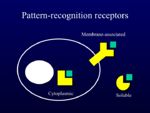Difference between revisions of "Recognition of Microorganisms"
Jump to navigation
Jump to search
Rjfrancisrvc (talk | contribs) |
|||
| Line 1: | Line 1: | ||
[[Image:PRRs.jpg|thumb|right|150px|Pattern Recognition Receptors - B. Catchpole, RVC 2008]] | [[Image:PRRs.jpg|thumb|right|150px|Pattern Recognition Receptors - B. Catchpole, RVC 2008]] | ||
| − | + | The innate immune system recognises components of pathogens which are intrinsically foreign (i.e. not present on normal mammalian cells), such as: | |
**Lipopolysaccharides of gram-negative bacteria | **Lipopolysaccharides of gram-negative bacteria | ||
**Peptidoglycans of gram-positive bacteria | **Peptidoglycans of gram-positive bacteria | ||
**Mannose sugars | **Mannose sugars | ||
**D-isoform amino acids | **D-isoform amino acids | ||
| − | + | These are known to the body as foreign as they are expressed as '''pathogen-associated molecular patterns''' (PAMPs) | |
* PAMPs are recognised by '''pattern recognition receptors''' (PRRs) expressed on mammalian cells | * PAMPs are recognised by '''pattern recognition receptors''' (PRRs) expressed on mammalian cells | ||
** Pattern recognition receptors are expressed on many different cell types, not just on phagocytes | ** Pattern recognition receptors are expressed on many different cell types, not just on phagocytes | ||
| Line 49: | Line 49: | ||
| Carbohydrates, all bacteria, dead cells | | Carbohydrates, all bacteria, dead cells | ||
|- | |- | ||
| − | | | + | | fMLP |
| Soluble | | Soluble | ||
| Formyl peptides (i.e. all bacteria) | | Formyl peptides (i.e. all bacteria) | ||
Revision as of 11:24, 10 May 2012
The innate immune system recognises components of pathogens which are intrinsically foreign (i.e. not present on normal mammalian cells), such as:
- Lipopolysaccharides of gram-negative bacteria
- Peptidoglycans of gram-positive bacteria
- Mannose sugars
- D-isoform amino acids
These are known to the body as foreign as they are expressed as pathogen-associated molecular patterns (PAMPs)
- PAMPs are recognised by pattern recognition receptors (PRRs) expressed on mammalian cells
- Pattern recognition receptors are expressed on many different cell types, not just on phagocytes
- Not all are expressed by all cells: different cell types express a different range of PRRs
- PRRs are either intracellular, membrane-associated or soluble:
- Recognition of pathogens via the cellular PRRs results in phagocytosis and inflammation
- Recognition of pathogens via the humoral PRRs results in various killing mechanisms
- Engagement of PRRs by PAMPs triggers:
- Phagocytosis
- The expression of cytokines, which brings about inflammation and other immune responses
| Receptor | Location | Ligands |
|---|---|---|
| TLR2 (Toll-like receptor) | Cell Membrane | Peptidoglycan of gram +ve bacteria |
| TLR3 | Cell Membrane | dsRNA of RNA viruses (e.g. avian influenza) |
| TLR4 | Cell Membrane | Lipoplysaccharide from gram-negative bacteria (e.g. E. coli, Salmonella) |
| TLR5 | Cell Membrane | Bacterial flagellin |
| TLR9 | Cell Membrane | Bacterial DNA (CpG DNA) |
| C-type lectins | Soluble | Carbohydrates, all bacteria, dead cells |
| fMLP | Soluble | Formyl peptides (i.e. all bacteria) |
| Complement receptors | Soluble | Fixed complement components (e.g. iC3b) |
| NOD2 | Cytoplasm | Peptidoglycan of gram +ve bacteria |
| dsRNA-dependent Protein Kinase Receptor | Cytoplasm | ds RNA of RNA viruses |
| Originally funded by the RVC Jim Bee Award 2007 |
